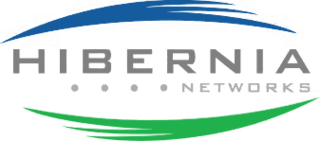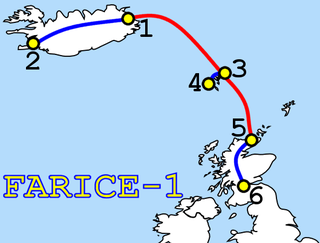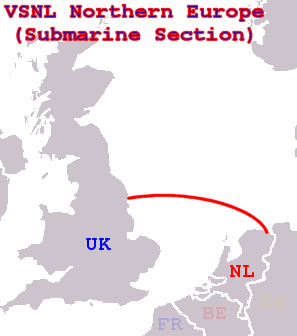Related Research Articles

The Svalbard Undersea Cable System is a twin submarine communications cable which connects Svalbard to the mainland of Norway. The two optical fiber cable consist of two segments, from Harstad to Breivika in Andøy, and from Breivika to Hotellneset near Longyearbyen in Svalbard. The segments from Harstad to Breivika are 74 and 61 kilometers long, respectively, and the segments from Breivika to Hotellneset 1,375 and 1,339 kilometers. Each consists of eight fiber pairs and there are twenty optical communications repeaters on each segment. Each segment has a speed of 10 gigabits per second (Gb/s), with a future potential capacity of 2,500 Gbit/s. The system is now the sole telecommunications link to the archipelago.

Hibernia Networks, alternately known as Hibernia Atlantic, was a privately held, US-owned provider of telecommunication services. It operated global network routes on self-healing rings in North America, Europe and Asia including submarine communications cable systems in the North Atlantic Ocean which connected Canada, the United States, the Republic of Ireland, the United Kingdom and mainland Europe. Hibernia managed cable landing stations in Dublin, Republic of Ireland; Coleraine, Northern Ireland; Southport, England; Halifax, Canada; Lynn, Massachusetts, United States.

FARICE-1 is a submarine communications cable connecting Iceland, the Faroe Islands and Scotland. The cable has been in use since January 2004 and is 100% owned by the Icelandic state. The cable had an initial design capacity of 720 Gbit/s and is a two fibre pair design. The length of the cable is 1205 km for the direct route between Iceland and Scotland. The cable structure and repeaters were made by Pirelli and the terminal equipment was supplied by TYCO. In the year 2013 the terminal equipment was upgraded by Ciena bringing the total capacity of the submarine cable to 11 Tbit/s. The cable has service access points in Reykjavik and Keflavik Airport as well as in London Telehouse East. The company Farice ehf sells services over the FARICE-1 cable. FARICE-2 was never built. DANICE is the complementary submarine cable.
AMERICAS-II is a fiber optic submarine communications cable that carries telecommunications between Florida, the U.S. Virgin Islands, Puerto Rico, Martinique, Curaçao, Trinidad and Tobago, Venezuela, French Guiana, Suriname and Guyana, and Brazil. It has been in service since August 2000 and is operated on a common carrier basis.

South East Asia–Middle East–Western Europe 4 is an optical fibre submarine communications cable system that carries telecommunications between Singapore, Malaysia, Thailand, Bangladesh, India, Sri Lanka, Pakistan, United Arab Emirates, Saudi Arabia, Egypt, Italy, Tunisia, Algeria and France. It is intended to be a complement to, rather than a replacement for, the SEA-ME-WE 3 cable.

Atlantic Crossing 1 (AC-1) is an optical submarine telecommunications cable system linking the United States and three European countries. It transports speech and data traffic between the U.S., the U.K., the Netherlands and Germany. It is one of several transatlantic communications cables. It was operated by American company Level 3 Communications and Irish company Tyco International, until their respective mergers in 2017 and 2016 with other companies.

Yellow / AC-2 is a submarine telecommunications cable system linking the United States and the United Kingdom. The cable is wholly owned by CenturyLink in the US following its acquisition of Global Crossing. The original owners, which each owned two of the fibre pairs, gave this cable system different names, so it is known as both Yellow and AC-2. It has a capacity of 320 Gbit/s as of January 2007, upgradeable to 640 Gbit/s.
VSNL International Canada or Tata Communications (Canada) ULC is an international telco carrier. The company is a subsidiary of Tata Communications, part of India's Tata Group and based in Montreal, Quebec. Part of their recent work has involved the updating of the CANTAT transatlantic cable system that connects the United Kingdom and Newfoundland under the Atlantic Ocean. The latest version of CANTAT, CANTAT-3, had a capacity of 5 Gbit/s in each direction across the Atlantic.
TGN-Pacific is a submarine telecommunications cable system transiting the Pacific Ocean.
VSNL Western Europe is a telecommunications cable system with both submarine and terrestrial parts linking several counties in western Europe.

VSNL Northern Europe is a telecommunications cable system with both submarine and terrestrial parts, connecting England and the Netherlands.
The Matrix Cable System (MCS) is a submarine telecommunications cable linking Indonesia and Singapore with a 2nd phase to Landing at Perth, Australia. It was constructed by Tyco.

Greenland Connect is a submarine communications cable system that connects Canada, Greenland, and Iceland. The cable contains two fibre pairs specified for 128*10 Gbit/s wavelength each. Initial lit capacity is 1*10 Gbit/s for each fibre pair. Two additional 10 Gbit/s Wavelength were installed in the summer of 2010. The cable has cable landing points at:

The West Africa Cable System (WACS) is a submarine communications cable linking South Africa with the United Kingdom along the west coast of Africa that was constructed by Alcatel-Lucent. The cable consists of four fibre pairs and is 14,530 km in length, linking from Yzerfontein in the Western Cape of South Africa to London in the United Kingdom. It has 14 landing points, 12 along the western coast of Africa and 2 in Europe completed on land by a cable termination station in London. The total cost for the cable system is $650 million. WACS was originally known as the Africa West Coast Cable (AWCC) and was planned to branch to South America but this was dropped and the system eventually became the West African Cable System.
Honotua is a submarine communications cable system that connects several islands of French Polynesia via Tahiti to Hawaii. The cable was laid by the cableship Île de Ré (câblier) between December 2009 and June 2010.

Tata Communications Limited is an Indian telecommunications company. Before its acquisition by Tata Group it was a government-owned telecommunications service provider and under the ownership of Department of Telecommunications, Ministry of Communications, and the Government of India. It was then sold to Tata Group in 2008 under first Manmohan Singh ministry government.

The Caucasus Cable System is a Georgian-owned submarine communications cable in the Black Sea linking Poti, Georgia to Balchik, Bulgaria over a distance of 1,182 km. Its landing station in Balchik is connected to Frankfurt, Germany and other European Internet hubs via terrestrial connection. As the only communications cable linking Georgia directly to Europe, the Caucasus Cable System is deemed of geostrategic importance and has been at the center of controversy due to alleged plans to sell it to a Russian-owned company. As of January 2017 the cable is still in sole ownership of Caucasus Online.

MAREA is a 6,605 km long transatlantic communications cable connecting the United States with Spain. Owned and funded by Microsoft and Meta Platforms, but constructed and operated by Telxius, a subsidiary of the Spanish telecom company Telefónica, it is the "highest-capacity submarine cable in the world" with a system design capacity of 200 terabits per second as of 2019.

NJFX, also known as New Jersey Fiber Exchange, is a Wall Township, NJ-based data center and subsea cable landing station operator. The company offers Tier 3 data center, meet-me room and colocation services, and a cable landing station on a 58 acre campus.
References
- "Tyco Telecommunications, Network Services on the Tyco Global Network – TGN, Presentation to LISHEP, February 17, 2004, Rio de Janeiro, Brazil" . Retrieved November 22, 2006.
- Dormon, Bob (2016-05-26). "How the Internet works: Submarine fiber, brains in jars, and coaxial cables". Ars Technica . Retrieved 2016-05-31.
- 1 2 3 "TGN Atlantic". Greg's Cable Map. Retrieved 2016-05-31.
- ↑ "Business : VSNL to acquire Tyco's submarine cable network". The Hindu . 2004-11-02.[ dead link ]
- ↑ "History". Tata Communications. 2015-03-07. Retrieved 2016-05-31.
- ↑ "Tata Communications brings 100G connectivity to carriers and enterprises across the US and Europe using Ciena's GeoMesh". Tata Communications. 2013-09-20. Retrieved 2016-05-31.